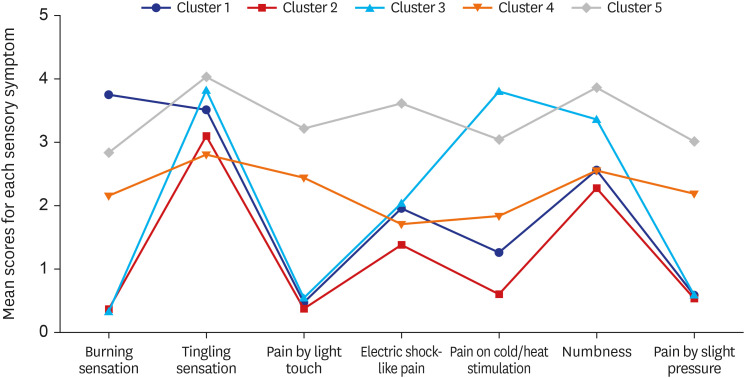J Korean Med Sci.
2022 Jan;37(3):e8. 10.3346/jkms.2022.37.e8.
Subgrouping of Peripheral Neuropathic Pain Patients According to Sensory Symptom Profile Using the Korean Version of the PainDETECT Questionnaire
- Affiliations
-
- 1Department of Neurology, Konkuk University Medical Center, Konkuk University School of Medicine, Seoul, Korea
- 2Department of Neurology, Uijeongbu Eulji Medical Center, Eulji University School of Medicine, Uijeongbu, Korea
- 3Department of Neurology, Kangbuk Samsung Medical Center, Sungkyunkwan University School of Medicine, Seoul, Korea
- 4Department of Neurology, Chungnam National University Hospital, Daejeon, Korea
- 5Department of Neurology, Ajou University School of Medicine, Suwon, Korea
- KMID: 2524895
- DOI: http://doi.org/10.3346/jkms.2022.37.e8
Abstract
- Background
A culturally validated Korean version of the PainDETECT Questionnaire (PD-Q) was used to identify neuropathic pain components (NeP) in patients suffering from chronic pain. The purpose of this study was to determine if the Korean PD-Q can be used to subgroup patients with peripheral NeP according to sensory symptom profiles.
Methods
This study included 400 Korean patients with peripheral neuropathic pain diagnosed as probable or definite NeP. The total scores and subscores for each item in PD-Q were transformed into a Z-score for standardization. Hierarchical cluster analysis was performed to identify clusters of subjects by PD-Q scores.
Results
The mean total PD-Q score of the study participants was 14.57 ± 6.46. A hierarchical cluster analysis identified 5 clusters with distinct pain characteristic profiles. Cluster 1 had relatively severe burning and tingling sensations. The mean total PD-Q score for cluster 2 was the lowest of the 5 clusters. Cluster 3 tended to be vulnerable to pain in response to cold/heat stimulation. Cluster 4 showed relatively severe pain induced by physical stimuli, such as light touch or slight pressure. Cluster 5 had high scores for all NeP symptoms.
Conclusion
This study demonstrates the ability of patients to cluster by symptoms using the Korean PD-Q. Subgrouping of peripheral neuropathic pain by sensory symptom profile may be useful in making effective drug treatment decisions.
Keyword
Figure
Reference
-
1. von Hehn CA, Baron R, Woolf CJ. Deconstructing the neuropathic pain phenotype to reveal neural mechanisms. Neuron. 2012; 73(4):638–652. PMID: 22365541.
Article2. Baron R, Maier C, Attal N, Binder A, Bouhassira D, Cruccu G, et al. Peripheral neuropathic pain: a mechanism-related organizing principle based on sensory profiles. Pain. 2017; 158(2):261–272. PMID: 27893485.
Article3. Freynhagen R, Baron R, Gockel U, Tölle TR. painDETECT: a new screening questionnaire to identify neuropathic components in patients with back pain. Curr Med Res Opin. 2006; 22(10):1911–1920. PMID: 17022849.
Article4. Tampin B, Briffa NK, Slater H. Self-reported sensory descriptors are associated with quantitative sensory testing parameters in patients with cervical radiculopathy, but not in patients with fibromyalgia. Eur J Pain. 2013; 17(4):621–633. PMID: 23108871.
Article5. De Andrés J, Pérez-Cajaraville J, Lopez-Alarcón MD, López-Millán JM, Margarit C, Rodrigo-Royo MD, et al. Cultural adaptation and validation of the painDETECT scale into Spanish. Clin J Pain. 2012; 28(3):243–253. PMID: 21926908.
Article6. Timmerman H, Wolff AP, Schreyer T, Outermans J, Evers AW, Freynhagen R, et al. Cross-cultural adaptation to the Dutch language of the PainDETECT-Questionnaire. Pain Pract. 2013; 13(3):206–214. PMID: 22776283.
Article7. Alkan H, Ardic F, Erdogan C, Sahin F, Sarsan A, Findikoglu G. Turkish version of the painDETECT questionnaire in the assessment of neuropathic pain: a validity and reliability study. Pain Med. 2013; 14(12):1933–1943. PMID: 23924395.
Article8. Matsubayashi Y, Takeshita K, Sumitani M, Oshima Y, Tonosu J, Kato S, et al. Validity and reliability of the Japanese version of the painDETECT questionnaire: a multicenter observational study. PLoS One. 2013; 8(9):e68013. PMID: 24098629.
Article9. Sung JK, Choi JH, Jeong J, Kim WJ, Lee DJ, Lee SC, et al. Korean version of the painDETECT questionnaire: a study for cultural adaptation and validation. Pain Pract. 2017; 17(4):494–504. PMID: 27400761.
Article10. Baron R, Tölle TR, Gockel U, Brosz M, Freynhagen R. A cross-sectional cohort survey in 2100 patients with painful diabetic neuropathy and postherpetic neuralgia: Differences in demographic data and sensory symptoms. Pain. 2009; 146(1-2):34–40. PMID: 19592166.
Article11. Finnerup NB, Haroutounian S, Kamerman P, Baron R, Bennett DL, Bouhassira D, et al. Neuropathic pain: an updated grading system for research and clinical practice. Pain. 2016; 157(8):1599–1606. PMID: 27115670.
Article12. Attal N, de Andrade DC, Adam F, Ranoux D, Teixeira MJ, Galhardoni R, et al. Safety and efficacy of repeated injections of botulinum toxin A in peripheral neuropathic pain (BOTNEP): a randomised, double-blind, placebo-controlled trial. Lancet Neurol. 2016; 15(6):555–565. PMID: 26947719.
Article13. Freeman R, Baron R, Bouhassira D, Cabrera J, Emir B. Sensory profiles of patients with neuropathic pain based on the neuropathic pain symptoms and signs. Pain. 2014; 155(2):367–376. PMID: 24472518.
Article14. Baron R, Förster M, Binder A. Subgrouping of patients with neuropathic pain according to pain-related sensory abnormalities: a first step to a stratified treatment approach. Lancet Neurol. 2012; 11(11):999–1005. PMID: 23079556.
Article15. Fields HL, Rowbotham M, Baron R. Postherpetic neuralgia: irritable nociceptors and deafferentation. Neurobiol Dis. 1998; 5(4):209–227. PMID: 9848092.
Article16. Pfizer PCOA. Neuropathic pain. Updated 2020. Accessed July 21, 2021. https://www.pfizerpcoa.com/paindetect-screener .
- Full Text Links
- Actions
-
Cited
- CITED
-
- Close
- Share
- Similar articles
-
- Evaluation and diagnosis of neuropathic pain
- Investigation of serum biomarkers for neuropathic pain in neuromyelitis optica spectrum disorder: a preliminary study
- Neuropathic Pain after Adolescent Idiopathic Scoliosis Correction Surgery
- Short-Term Pain Relief by Repetitive Peripheral Magnetic Stimulation in Patients with Musculoskeletal Pain: A Pilot Study
- Risk Factors of Neuropathic Pain after Total Hip Arthroplasty


